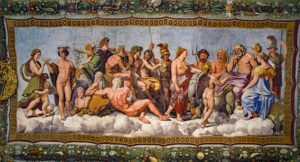
What we know as the Renaissance marked a period of remarkable transformations that reverberated across various spheres. This phenomenon, which took place between the 14th and 17th centuries, revolutionized culture, the perception of the world, and human thought. We observe a resurgence of thought, with humanity striving to explain the world from its perspective, developing a more humanistic view centered on the individual.
In the cultural sphere, its impact was considerable, and its influence persists in how we understand the world today. In disciplines like art and painting, significant advances were achieved by perfecting representation with more realistic nuances. For instance, Masaccio stood out by portraying real faces in his paintings, something unique at that time. Individuals were depicted in a space, indicating that humans were situated in an environment subordinate to principles invented by the human mind and its harmony with the surroundings.
Observation of nature and its artistic expression allowed for a better understanding, evolving towards a more realistic representation with individuals firmly grounded. This symbolized a stronger connection to the surrounding reality, showing an evolution from earlier art where individuals seemed suspended in the air.
The detailed observation of natural events during the Renaissance facilitated a better understanding through the study of these events, many of which are still taught in contemporary universities.
Writers were also influenced by the Renaissance, manifesting in their works the dilemma between individual things and their meaning and values.
So, was it truly a rebirth, a transformation, or a rediscovery? The Renaissance did not resurrect something dead but developed something that already existed, discovering a way to explain the world from the human perspective.
At the start of the Renaissance, humans had their place in nature, but over time, they placed themselves above everything, becoming increasingly independent and paving the way for humanism with its currents that persist to this day.
The Renaissance humanist believed in reviving the pre-Christian era, the golden age of the ancient Romans and Greeks. Centuries later, Thomas Aquinas paved the way by emphasizing Aristotle’s teachings, as depicted in Raphael’s work “The School of Athens,” where the central figures are Plato and Aristotle. Plato points upward, towards God and the eternal, while Aristotle, with his palm downward, points to the earthly, the individual, nature, and man.
This dilemma between humanism, the Bible, and Christianity leads to a starting point that begins with man as an autonomous being, where truth is relative or, if there is truth, it comes from another source and must be absolute, pointing towards God.
The independence of human thought and the importance given to the individual over the whole lead humanity towards a state of degradation and fragmentation, resulting in the loss of integrity at the individual, social, and ethical levels. This leads to a loss of meaning and purpose that results in failure. The only viable solution leads us to God as the source of purpose and meaning in human life, as He gives meaning to the entire mechanism and functioning of creation.
Author: Mesac Martinez
0 Comments